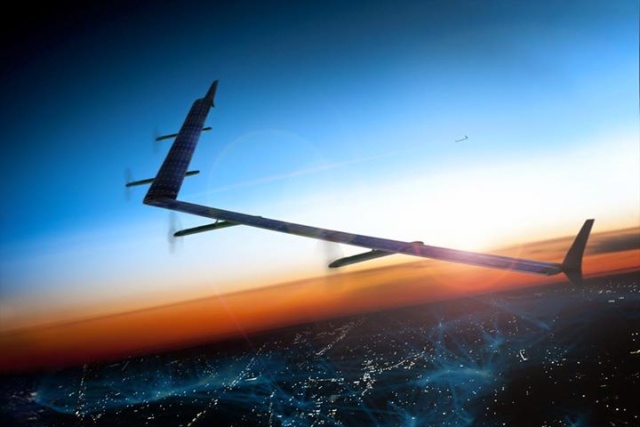SpaceX isn't the only company with crazily ambitious plans to bring the Internet to the remote corners of the globe.
Facebook announced yesterday that it has completed the first test flight of a high-altitude laser-equipped Internet drone.
Yes, really. Facebook has drones. With lasers.
Mark Zuckerberg posted on his Wall yesterday:
As part of our Internet.org effort to connect the world, we've designed unmanned aircraft that can beam internet access down to people from the sky.
Today, I'm excited to share that we've successfully completed our first test flight of these aircraft in the UK.
The final design will have a wingspan greater than a Boeing 737 but will weigh less than a car. It will be powered by solar panels on its wings and it will be able to stay at altitudes of more than 60,000 feet for months at a time.
Aircraft like these will help connect the whole world because they can affordably serve the 10% of the world's population that live in remote communities without existing internet infrastructure.

Dubbed Aquila - the solar-powered drones being developed by Facebook will loiter for months at a time over target areas - well above most weather.
Using lasers, squadrons of thousands of drones will communicate with each other through the atmosphere, providing Internet backbone access down to local ground stations that will then broadcast high-speed Internet to the surrounding areas.
Facebook's goal is ambitious - they hope to bring the Internet to billions of people who may never have even had access to reliable electricity: "allowing everyone in the world to participate in the Internet."
Drone Wars & Other Looney Ideas

Facebook isn't the only one envisioning a drone filled connected sky. According to FCC documents, Google asked for permission to begin test flying its Titan drones last October high above New Mexico - and a few weeks ago Google confirmed that they are on track to conduct a maiden flight later this year.
Google's Titan drones are joining Google's Project Loon stratospheric balloons that have already been tested in New Zealand. The Loon balloons float with the winds, beaming down internet service to those below.
The tagline: "Balloon-Powered Internet For Everyone".
Google's Project Loon video:
Drones, Balloons, Satellites, and Pies - All In The Sky?!?
The headlines lately are straight out of science fiction, and the technology being demonstrated is indeed innovative and exciting. But even if everything goes perfectly according to the still mostly secret plans, it will be at a minimum 3-5 years before these new technologies begin to be deployed.
Don't get too excited just yet - your RV isn't going to get a drone uplink anytime soon.
But the ideas being tested here are NOT crazy. Drones flying in figure 8's ten miles up in the sky have the potential to be the ultimate cell towers - with perfect line of site to a huge area down below. In remote rural areas, and especially in third world countries lacking much existing infrastructure, these sorts of atmospheric technologies have the potential to deliver tons of bandwidth - vastly cheaper than even next generation satellite constellations ever could.
We have an exciting future ahead of us!








 Mobile Internet Resource Center (dba Two Steps Beyond LLC) is founded by Chris & Cherie of
Mobile Internet Resource Center (dba Two Steps Beyond LLC) is founded by Chris & Cherie of